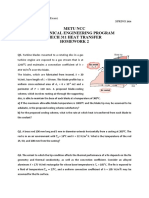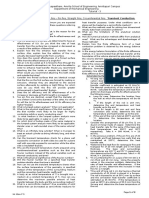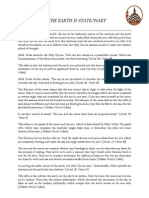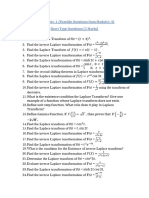04 Heat Transfer From Extended Surfaces
Uploaded by
camaradiya04 Heat Transfer From Extended Surfaces
Uploaded by
camaradiyaMARWADI EDUCATION FOUNDATIONS GROUP OF INSTITUTIONS FACULTY OF ENGINEERING, GAURIDAD CAMPUS.
DEPARTMENT OF MECHANICAL ENGINEERING
Subject / Subject Code HMT / 161902
Semester / Branch TH 6 M.E(FOT)
Issue Date 24/02/2014
Due Date 10/03/2014
Assignment # 4
1. 2. 3. 4. 5. What is the utility of extended surfaces? Give 10 specific and practical examples of use of fin in heat transfer. What are the varies types of fins? List the assumption made while analyzing the heat flow from a finned surfaces. Derive governing differential equation for temperature distribution of constant area extended surface in the following form: = = m2
6. For a constant cross section area fin, obtain the temperature distribution and total heat flow rate under steady state conditions when one end of fin is attached at high temperature and other end of the fin is insulated(fin insulated at tip). 7. For a constant cross section area fin, obtain the temperature distribution and total heat flow rate under steady state conditions when one end of fin is attached at high temperature and heat is dissipate from other end. 8. Develop expression for temperature distribution and total heat flow rate under steady state conditions for an infinitely long fin. 9. Define and derive expression for fin performance and fin efficiency. 10. A fin 30 cm long and 10 mm diameter throughout is made up of steel alloy of thermal conductivity 43 W/m-deg. The fin attached to a plane heated wall at 200 0C temperature, extended into surrounding at 25 0 C and unit surface coefficient of 120 W/m2-deg. Work out the heat flow rate from the fin to surrounding. Assume fin is insulated at tip. 11. A longitudinal copper fin(k = 14 kJ/m-hr-deg) 60 mm long and 5 mm in diameter is exposed to air stream at 20 0 C. The air moving past the fin has uniform convection coefficient h = 80 kJ/m2 hr deg. If the fin has a base temperature of 150 0C, determine the heat given up by the rod and its effectiveness in dissipation heat. 12. A 12.5 mm diameter rod of iron (k=45 W/m-deg)is heated to 260 0C at its base and protrudes into air 35 0C where surface conductance h = 8.5 W/m2-deg. How long must be the rod in order that its end temperature may be computed, with less than 2.75 0C error, by the use of infinite rod equations? What error in heat dissipation is made, at this length, by the use of the infinite rod equation?
MARWADI EDUCATION FOUNDATIONS GROUP OF INSTITUTIONS FACULTY OF ENGINEERING, GAURIDAD CAMPUS.
DEPARTMENT OF MECHANICAL ENGINEERING 13. A gas turbine blade made of stainless steel (k =32 W/m0C) is 70 mm long ,500 mm2 cross sectional area and 120 mm perimeter .The temperature of the root of blade is 500 0C and it is exposed to the combustion product of the fuel passing from turbine at 8300C.If the film coefficient between the blade and the combustion gases is 300 W/m20C, Determine: (1) The temperature at the middle of blade (2)The rate of heat flow from the blade. 14. Two rods A and B of equal diameter and equal length, but of different materials are used as fins. The both rods are attached to a plain wall maintained at 160 oC, while they are exposed to air at 30 oC. The end temperature of rod A is 100 oC while that of the rod B is 80 oC. If thermal conductivity of rod A is 380 W/mK, calculate the thermal conductivity of rod B. These fins can be assumed as short with end insulated.
Prof. Bhavesh Kanabar Subject In-Charge, Mechanical Engineering Dept. MEFGI
Prof. Pinank A. Patel Head of Department, Mechanical Engineering, MEFGI
You might also like
- (An Autonomous Institute Under VTU) Manandavadi Road, Mysore-570008, Karnataka, India100% (1)(An Autonomous Institute Under VTU) Manandavadi Road, Mysore-570008, Karnataka, India2 pages
- MIN-305 Heat & Mass Transfer Tutorial - 2No ratings yetMIN-305 Heat & Mass Transfer Tutorial - 22 pages
- Heat Transfer From Extended Surfaces: Course ContentsNo ratings yetHeat Transfer From Extended Surfaces: Course Contents23 pages
- Metu NCC Mechanical Engineering Program Mech 311 Heat Transfer Homework 2No ratings yetMetu NCC Mechanical Engineering Program Mech 311 Heat Transfer Homework 22 pages
- CHG 2314 Heat Transfer Operations Winter 2011: Assignment 4No ratings yetCHG 2314 Heat Transfer Operations Winter 2011: Assignment 43 pages
- ME8693-Heat and Mass Transfer IAE 1 Important Questions Part-A 1. 2. 3. 4. 5. 6. 7. 8. 9. 10. 11. 12No ratings yetME8693-Heat and Mass Transfer IAE 1 Important Questions Part-A 1. 2. 3. 4. 5. 6. 7. 8. 9. 10. 11. 122 pages
- (3) Temperature Distribution on Pin Fin Heatsinks (柱狀陣列熱沉溫度分佈) - 2017No ratings yet(3) Temperature Distribution on Pin Fin Heatsinks (柱狀陣列熱沉溫度分佈) - 20178 pages
- ME3691-HEAT AND MASS TRANSFER-1565247191-ME3691 HMT Reg 2021 Question BankNo ratings yetME3691-HEAT AND MASS TRANSFER-1565247191-ME3691 HMT Reg 2021 Question Bank14 pages
- Gujarat Technological University: Teaching and Examination SchemeNo ratings yetGujarat Technological University: Teaching and Examination Scheme2 pages
- Chapter 12 - "Inventory Planning and Control"No ratings yetChapter 12 - "Inventory Planning and Control"13 pages
- Computational Welding Simulation of A Plasma Wire Arc Additive Manufacturing Process For High-Strength SteelNo ratings yetComputational Welding Simulation of A Plasma Wire Arc Additive Manufacturing Process For High-Strength Steel16 pages
- Effect of Various Parameters On The Performance of Cooling TowerNo ratings yetEffect of Various Parameters On The Performance of Cooling Tower21 pages
- Bending of High Strength Steel Docol Domex Hardox WeldoxlNo ratings yetBending of High Strength Steel Docol Domex Hardox Weldoxl8 pages
- Numerical Modeling of Vertical Drains With Smear ANo ratings yetNumerical Modeling of Vertical Drains With Smear A15 pages
- OpenFilters Open-Source Software For The Design, Optimization, and Synthesis of Optical FiltersNo ratings yetOpenFilters Open-Source Software For The Design, Optimization, and Synthesis of Optical Filters12 pages
- University of California Berkeley Physics Problems With Solutions0% (1)University of California Berkeley Physics Problems With Solutions25 pages
- Stochastic Calculus - An Introduction With Applications PDFNo ratings yetStochastic Calculus - An Introduction With Applications PDF246 pages
- Chang K. Mathematical Structures of Quantum Mechanics 2011100% (1)Chang K. Mathematical Structures of Quantum Mechanics 2011208 pages
- How To Calculate A Spring Constant Using Hooke's LawNo ratings yetHow To Calculate A Spring Constant Using Hooke's Law2 pages


































































































